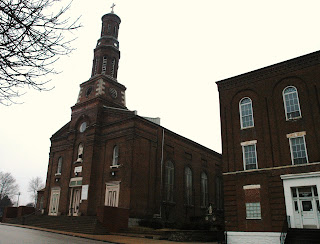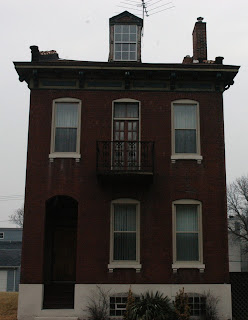The 2000 census data counted 4,327 residents (down 10% from 1990's count) of whom 97% were black, 2% white. There were 1,648 housing units counted, 97% occupied (84%/16% owner/renter split).
This is a very high occupancy and owner rate for a north St. Louis neighborhood. The highest I've seen so far. This bodes well.
Here's some info from the neighborhood website:
Institutions: This quaint and stable neighborhood is home to the North Park United Methodist Church and Mizpah Lutheran Church. The Herzog Elementary School and Northwest Middle School has provided quality primary education to many generations of children in the neighborhood. Lot a Luv and New Northside Child Development Centers offers convenient a quality child care to the working parents of the North Point neighborhood. The Riverview/West Florissant Housing Corporation provides area residents with access to housing information and administer the implementing housing development projects. On the outer boundaries of the neighborhood major employers are present. Boatmen's Bank (Nations) is the only institution, North Point is primary a residential area.
Characteristics: This thriving middle class neighborhood is one of the most stable neighborhoods in the city. It has been able to weather urban crisis and population shifts without affecting its stability. The neighborhood has maintained its residential middle class flavor and has a quaint suburban quality. Smaller one-and two-bedroom bungalows and fewer larger frame homes are found throughout the neighborhood. The majority of housing in the North Point neighborhood was constructed between 1938 and 1940's. Currently nearly 85% of the housing available is owner occupied. Proximity to quality education's institution make innovative and challenging education's opportunities available to the children residing in the neighborhood. Several commercial districts are found on the outskirts along West Florissant, Goodfellow and the Halls Ferry Circle.That sounds pretty good, eh? Quaint, stable, middle class...that all sounds pretty positive. Although this information might be quite dated as per the Boatman's Bank reference in paragraph 1. Boatman's Bank was bought out by Nations Bank in 1996 and then became Bank of America.
Before I show you what I saw today, let me say this is in the top 5 most stable, spic-n-span clean neighborhooods I've seen to date. I was blown away by this awesome neighborhood. It's like the Southampton of the north, only maybe cooler because of it's proximity to Calvary Cemetery, the wicked cool turnabout at the convergence of Riverview, Halls Ferry and Goodfellow.
This neighborhood is arguably better cared for than most south side hoods. Meaning, there are new sidewalks and curb cuts everywhere. They are handicap/stroller/bike accessible corners, beautiful street lights, impeccable city and private landscaping. There are established bike lanes along Riverview that are clearly marked with ample sinage:
There are striking new gates at several entry points.
Even the railroad tracks that cut through North Pointe have old growth trees beautifully spaced along the easements within the neighborhood. The cool train bridge over Riverview (one of the most fascinating streets in the city) are landscaped. The aldermen need to be acknowledged here. This place is absolutely beautiful.
If you got a job at Express Scripts or UMSL or any of the other north city/county major employers, this would be among the best places to live. I'd move here in a heart beat.
The roofs, the sidewalks, the yards, the alleys, the tuckpointing are overwhelmingly being cared for on the residential properties. Many little gingerbreads have been updated with central air, personal investment is evident everywhere. This neighborhood is pridefully cared for, congrats to all those North Pointers out there maintaining this beautiful place for the next generations to come.
So let's take a look at some late 1930's - 1940's home in a stable north St. Louis neighborhood:
^Love the capital "R" on the awnings.
The angles at which the homes along Riverview Blvd. were built is really cool, they are kind of staggered and slightly angled from the bend of the road. I tried to photograph it but it doesn't come through; go check it out for yourself.
There are also more 1940's/1950's homes stylishly mixed in:There are VERY few non-brick structures, but the ones I found were out of sight:
^This is now in my top 10 favorite non-brick homes in St. Louis.
Businesses within North Pointe are plentiful on the outskirts and the vacancy rates in the retail buildings appear to be consistent with those all over the city:
Check out the awesome little greenspace at Astra and Vivian avenues. The homes face each other along this circle. It reminds me of Holly Hills or St. Louis Hills.
Herzog Elementary:
Nance school:

What a beautiful neighborhood! What a great way to start this beautiful Saturday...an even prouder St. Louisian than I was before. My daughter and I stopped in the Walnut Park Library on our way out to check out the music selection and get a couple books. Just like all the other branches, this is a clean, safe, beautiful library.
If you haven't explored North St. Louis, start now. It's awesome! Try heading north on Riverview Blvd., it's amazing. Just think of what St. Louis would be like if the middle class had not abandoned her in previous decades.































































































